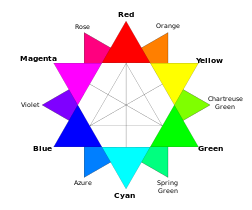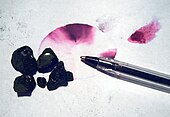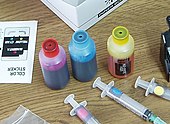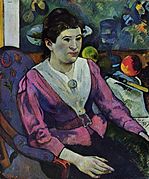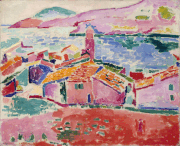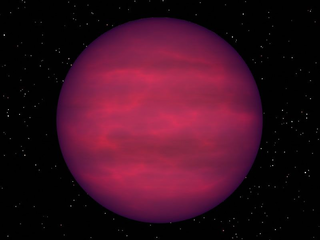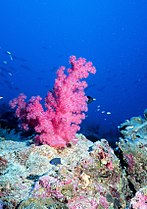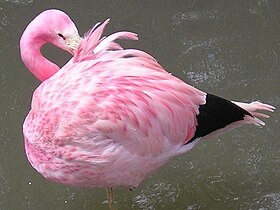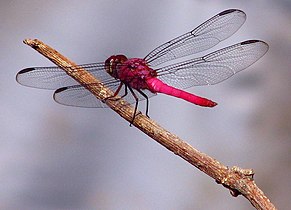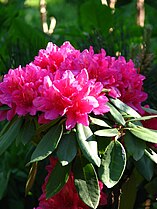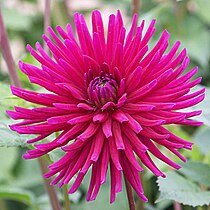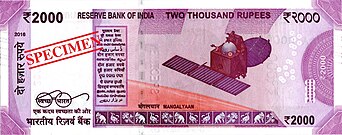Magenta
| Magenta | |
|---|---|
| Hex triplet | #FF00FF |
| sRGBB(r,g,b) | (255, 0, 255) |
| HSV(h,s,v) | (300°, 100%, 100%) |
| CIELChuv(L,C,h) | (60, 137, 308°) |
| Source | CSS Color Module Level 3 |
| B:Normalized to [0–255] (byte) H:Normalized to [0–100] (hundred) | |
Magenta(/məˈdʒɛntə/) is apurplish-redcolor.[1][2]Oncolor wheelsof theRGB (additive)andCMY (subtractive)color models, it is located precisely midway betweenblueandred.It is one of the four colors of ink used in color printing by aninkjet printer,along withyellow,cyan,andblackto make all the other colors. The tone of magenta used inprinting,printer's magenta,is redder than the magenta of the RGB (additive) model, the former being closer torose.
Magenta took its name from ananilinedye made and patented in 1859 by the French chemist François-Emmanuel Verguin, who originally called itfuchsine.It was renamed to celebrate the Italian-French victory at theBattle of Magentafought between the French and Austrians on 4 June 1859 near the Italian town ofMagentainLombardy.[3][4]A virtually identical color, called roseine, was created in 1860 by two British chemists, Edward Chambers Nicholson, and George Maule.
Theweb colormagenta is also calledfuchsia.
In optics and color science[edit]

Magenta is anextra-spectral color,meaning that it is not a hue associated with monochromaticvisible light.Magenta is associated with perception ofspectral power distributionsconcentrated mostly in two bands: longer wavelength reddish components and shorter wavelength blueish components.[5]
In the RGB color system, used to create all the colors on a television or computer display, magenta is a secondary color, made by combining equal amounts of red and blue light at a high intensity. In this system, magenta is thecomplementary colorof green, and combining green and magenta light on a black screen will create white.

In theCMYK color model,used in color printing, it is one of the three primary colors, along with cyan and yellow, used to print all the rest of the colors. If magenta, cyan, and yellow are printed on top of each other on a page, they make black. In this model, magenta is the complementary color of green. If combined, green and magenta ink will look dark brown or black. The magenta used in color printing, sometimes called process magenta, is a darker shade than the color used on computer screens.
In terms ofphysiology,the color is stimulated in the brain when the eye reports input from short wave bluecone cellsalong with a sub-sensitivity of the long wave cones which respond secondarily to that same deep blue color, but with little or no input from the middle wave cones. The brain interprets that combination as some hue of magenta or purple, depending on the relative strengths of the cone responses.
In theMunsell color system,magenta is calledred-purple.
If the spectrum is wrapped to form a color wheel, magenta (additive secondary) appears midway between red and violet. Violet and red, the two components of magenta, are at opposite ends of the visible spectrum and have very different wavelengths. The additive secondary color magenta is made by combining violet and red light at equal intensity; it is not present in the spectrum itself.
-
In theRGB color model,used to make colors on computer and television displays, magenta is created by the combination of equal amounts of blue and red light.
-
In the RGB color wheel ofadditive colors,magenta is midway between blue and red.
-
In theCMYK color model,used in color printing,cyan,magenta, andyellowcombined make black. In practice, since the inks are not perfect, some black ink is added.
-
Visible spectrum wrapped to join violet and red in an additive mixture of magenta. In reality, violet and red are at opposite ends of the spectrum and have very different wavelengths.
Fuchsia and magenta[edit]
Theweb colorsfuchsiaand magenta are identical, made by mixing the same proportions of blue and red light. In design and printing, there is more variation. The French version of fuchsia in theRGB color modeland in printing contains a higher proportion of red than the American version of fuchsia.[citation needed]
Gallery[edit]
-
The flower of theFuchsiaplant was the original inspiration for the dye, which was later renamed magenta dye.
-
Magenta took its name in 1860 from thisaniline dyethat was originally called "fuchsine",after the fuchsia flower.
-
Magenta has been used in color printing since the late nineteenth century. Images are printed in three colors; magenta, cyan, and yellow, which when combined can make all colors. This image from 1902 is using the alternativeRYB color modelinstead.
-
Color printers today use magenta, cyan, and yellow ink to produce the full range of colors.
-
Magenta is thecomplementary colorofgreen.The two colors combined in the RGB model form white.
-
TheIndonesian Marine Corpsberet color is magenta purple.
History[edit]
Fuchsine and magenta dye (1859)[edit]

The color magenta was the result of the industrial chemistry revolution of the mid-nineteenth century, which began with the invention byWilliam Perkinofmauveinein 1856, which was the first syntheticaniline dye.The enormous commercial success of the dye and the new color it produced,mauve,inspired other chemists in Europe to develop new colors made from aniline dyes.[3]
In France, François-Emmanuel Verguin, the director of the chemical factory of Louis Rafard nearLyon,tried many different formulae before finally in late 1858 or early 1859, mixing aniline withcarbon tetrachloride,producing a reddish-purple dye which he called "fuchsine",after the color of the flower of the fuchsia plant.[6]He quit the Rafard factory and took his color to a firm of paint manufacturers, Francisque and Joseph Renard, who began to manufacture the dye in 1859.
In the same year, two British chemists, Edward Chambers Nicholson and George Maule, working at the laboratory of the paint manufacturer George Simpson, located in Walworth, south of London, made another aniline dye with a similar red-purple color, which they began to manufacture in 1860 under the name "roseine". In 1860 they changed the name of the color to "magenta", in honor of theBattle of Magentafought by the armies of France andSardiniaagainst Austrians atMagenta, Lombardythe year before, and the new color became a commercial success.[3][7]
Starting in 1935 the family ofquinacridonedyes was developed. These have colors ranging from red to violet, so nowadays a quinacridone dye is often used for magenta. Various tones of magenta—light, bright, brilliant, vivid, rich, or deep—may be formulated by adding varying amounts of white to quinacridone artist's paints.
Another dye used for magenta isLithol Rubine BK.One of its uses is as a food coloring.
Process magenta (pigment magenta; printer's magenta) (1890s)[edit]
| Process magenta (subtractive primary, sRGB approximation) | |
|---|---|
| Hex triplet | #FF0090 |
| sRGBB(r,g,b) | (255, 0, 144) |
| HSV(h,s,v) | (326°, 100%, 100%) |
| CIELChuv(L,C,h) | (55, 137, 350°) |
| Source | [Unsourced] |
| ISCC–NBS descriptor | Vivid purplish red |
| B:Normalized to [0–255] (byte) | |
Incolor printing,the color calledprocess magenta,pigment magenta,orprinter's magentais one of the three primary pigment colors which, along withyellowandcyan,constitute the threesubtractive primary colorsof pigment. (The secondary colors of pigment are blue, green, and red.) As such, the hue magenta is thecomplementofgreen:magentapigmentsabsorb green light; thus magenta and green are opposite colors.
TheCMYKprinting process was invented in the 1890s, when newspapers began to publish colorcomic strips.
Process magenta is not anRGBcolor, and there is no fixed conversion from CMYK primaries to RGB. Different formulations are used for printer's ink, so there may be variations in the printed color that is pure magenta ink.
Web colors magenta and fuchsia[edit]
| Magenta (Fuchsia) | |
|---|---|
| Hex triplet | #FF00FF |
| sRGBB(r,g,b) | (255, 0, 255) |
| HSV(h,s,v) | (300°, 100%, 100%) |
| CIELChuv(L,C,h) | (60, 137, 308°) |
| Source | X11 |
| ISCC–NBS descriptor | Vivid purple |
| B:Normalized to [0–255] (byte) | |
Theweb colormagentais one of the three secondary colors in theRGB color model. On theRGB color wheel,magenta is the color betweenroseandviolet,and halfway betweenredandblue.
This color is calledmagentainX11andfuchsiainHTML.In the RGB color model, it is created by combining equal intensities of red and blue light. The two web colors magenta andfuchsiaare exactly the same color. Sometimes the web color magenta is calledelectric magentaorelectronic magenta.
While the magenta used in printing and the web color have the same name, they have important differences. Process magenta (the color used for magenta printing ink—also called printer's or pigment magenta) is much less vivid than the color magenta achievable on a computer screen. CMYK printing technology cannot accurately reproduce on paper the color on the computer screen. When the web color magenta is reproduced on paper, it is called fuchsia and it is physically impossible for it to appear on paper as vivid as on a computer screen.
Colored pencils andcrayonscalled "magenta" are usually colored the color ofprocess magenta(printer's magenta).
In science and culture[edit]
In art[edit]
- Paul Gauguin(1848–1903) used a shade of magenta in 1890 in his portrait of Marie Lagadu, and in some of his South Seas paintings.
- Henri Matisseand the members of theFauvistmovement used magenta and other non-traditional colors to surprise viewers, and to move their emotions through the use of bold colors.
- Since the mid-1960s, water based fluorescent magenta paint has been available to paintpsychedelicblack lightpaintings.(Fluorescentcerise,fluorescentchartreuse yellow,fluorescent blue, and fluorescent green.)
-
Magenta, along with mauve, made with the newly discoveredaniline dyes,became a popular fashion color in the second half of the nineteenth century. It appeared in art in this 1890 work,Psyche,byBouguereau.
-
Paul Gauguin,Portrait of Marie Lagadu(1890).
-
Henri Matisse,Les toits de Collioure(1905). Henri Matisse and the other painters of theFauvistmovement were the first to make a major use of magenta to surprise and make an impact on the emotions of the viewer.
-
In the 1960s, magenta was a popular color inpsychedelic art,such as this concert poster for theAvalon BallroominSan Francisco(1967).
In literature[edit]
- The color plays a central role inCraig Laurance Gidney's novelA Spectral Hue.
In film[edit]
- The titular alien entity in the 2019 horror filmColor Out of Space,an adaptation of the 1927H. P. Lovecraftshort storyThe Colour Out of Space,is depicted as being magenta due to the color’s extra-spectral status.
In astronomy[edit]
- Astronomers have reported thatspectral classT brown dwarfs (the ones with the coolest temperatures except for the recently discovered Y brown dwarfs) are colored magenta because of absorption bysodiumandpotassiumatomsof light in the green portion of the spectrum.[8][9][10]
-
Artist's vision of a spectral class T brown dwarf
In biology: magenta insects, birds, fish, and mammals[edit]
-
Coralfrom thePersian Gulf
-
An Andeanflamingo,(Phoenicopterus andinus)
-
Adragonfly,orAnisopteraAna Cotta
-
Pseudanthiastuka, a reef fish from theIndian Ocean
In botany[edit]
Magenta is a common color for flowers, particularly in the tropics and sub-tropics. Because magenta is the complementary color of green, magenta flowers have the highest contrast with the green foliage, and therefore are more visible to the animals needed for their pollination.[citation needed]
-
OrchidPhalaenopsis
-
Clematis"Sunset"
-
Dahlia"Hillcrest Royal"
-
Ramblerrose
-
Syringa"Paul Deschanel"
-
Lily"Malinoviy Zvon"
-
Acactusflower
-
Achillea"Staroe Burgundskoe"
-
Mirabilis jalapa"Four O'Clock Flower"
In business[edit]
TheGermantelecommunications companyDeutsche Telekomuses a magentalogo.It has sought to prevent use of any similar color by other businesses, even those in unrelated fields, such as the insurance companyLemonade.[11]
In public transport[edit]
Magenta was the English name of Tokyo'sOedosubway line color. It was later changed toruby. It is also the color of theMetropolitan lineof theLondon Underground.
In transportation[edit]
In aircraftautopilotsystems, the path that pilot or plane should follow to its destination is usually indicated in cockpit displays using the color magenta.[12]
In numismatics[edit]
TheReserve Bank of India(RBI) issued a Magenta colored banknote of₹2000denomination on 8 November 2016 underMahatma Gandhi New Series.This is the highest currency note printed by RBI that is in active circulation inIndia.
-
Indian 2000 rupeenote, obverse
-
Indian 2000 rupeenote, reverse
In vexillology and heraldry[edit]
Magenta is an extremely rare color to find on heraldic flags and coats of arms,[13]since its adoption dates back to relatively recent times. However, there are some examples of its use:
-
Flag of themunicipality of Cartago,Colombia.
In politics[edit]
-
The Austrian NEOS party flag
- Throughout much of Europe, the color of magenta or variants of such, such asPinkorAmaranth,is used to symbolisesocial liberalismorclassical liberalism[14]
- The color magenta is used to symbolizeanti-racismby theAmsterdam-based anti-racism Magenta Foundation.[15]
- In Danish politics magenta is the color ofDet Radikale Venstre,the Danish social-liberal party.
- In Austrian Politics, it is used to representNEOS – The New Austria and Liberal Forum,a social liberal party.
- In Belgium it is used byDéFI,a social liberal party.
- In Germany, Magenta is one of the colors of theFree Democratic Party,or FDP.
See also[edit]
References[edit]
- ^Webster's New World Dictionary of the American Language(1964)
- ^definition of magentain Oxford dictionary (American English) (US)
- ^abcPhilip Ball (2001).Bright Earth: Art and the Invention of Color(illustrated ed.). University of Chicago Press. p. 214.ISBN978-0226036281.Retrieved27 July2014.Originally referenced from French edition pp. 311–312ISBN978-2754105033
- ^St. Clair, Kassia (2016).The Secret Lives of Color.London: John Murray. pp. 167–168.ISBN978-1473630819.OCLC936144129.
- ^Parkin, Alan (2015).Digital Imaging Primer.Springer Science & Business Media. p. 278.ISBN978-3540856191.
- ^St. Clair, Kassia (2016).The Secret Lives of Colour.London: John Murray. pp. 16–168.ISBN978-1473630819.OCLC936144129.
- ^Maerz and Paul.A Dictionary of Color,New York: 1930 McGraw-Hill. p. 126 Plate 52 Color Sample K12–Magenta
- ^Brown Dwarves(go halfway down the website to see a picture of a magenta brown dwarf)
- ^Burrows et al. The theory of brown dwarfs and extrasolar giant planets. Reviews of Modern Physics 2001; 73: 719–765
- ^An Artist's View of Brown Dwarf TypesArchived2011-11-17 at theWayback Machine(26 June 2002) Dr. Robert Hurt of the Infrared Processing and Analysis Center
- ^Slefo, George P. (November 4, 2019)."T-Mobile says it owns exclusive rights to the color magenta".Ad Age.Retrieved2019-11-06.
- ^Mingle, Katie (2015-06-23)."Children of the Magenta (Automation Paradox, pt. 1)".99% Invisible.
- ^"coat of arms | Definition, History, Symbols, & Facts".Encyclopedia Britannica.Retrieved2021-05-11.
- ^https://liberalhistory.org.uk/wp-content/uploads/2014/10/84_Lippiatt_Party_colours.pdf
- ^Magenta Foundation.Organization websiteArchived2006-08-27 at theWayback Machine.


